Perhonen Space Ship - Adrian Marc





Perhonen Space Ship - Adrian Marc
More Posts from Epic-flight and Others

Traverse - 211226
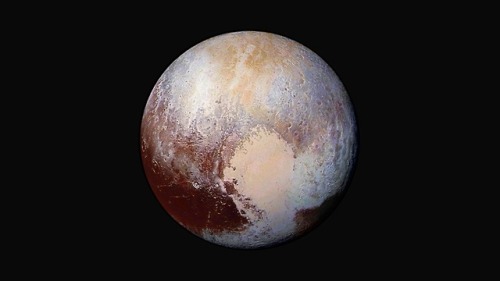

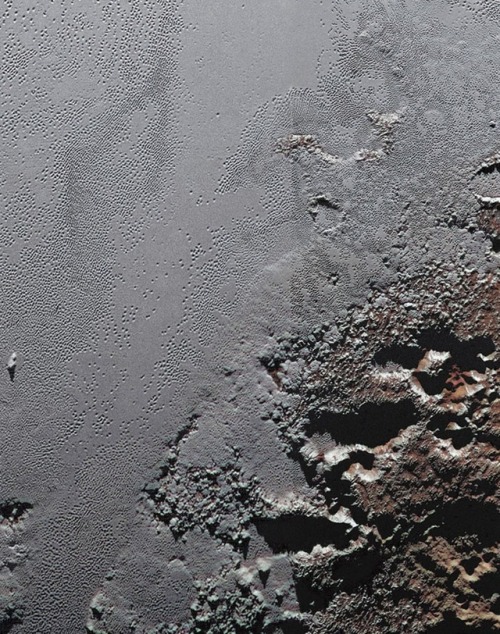
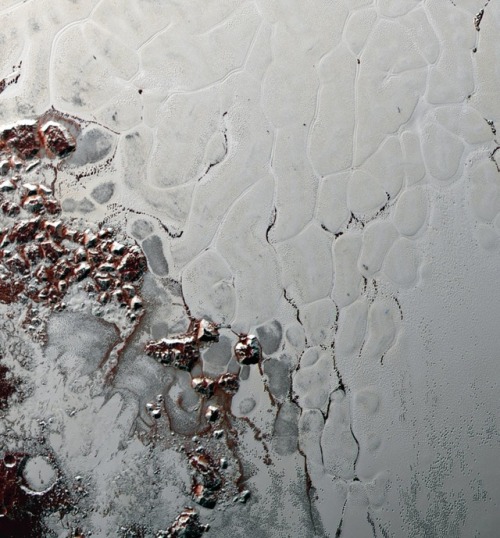
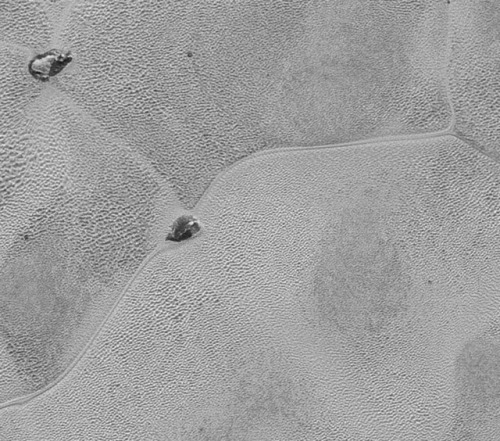
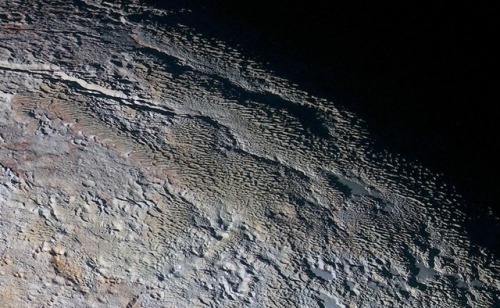
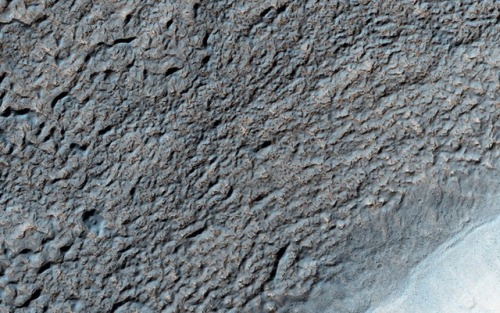
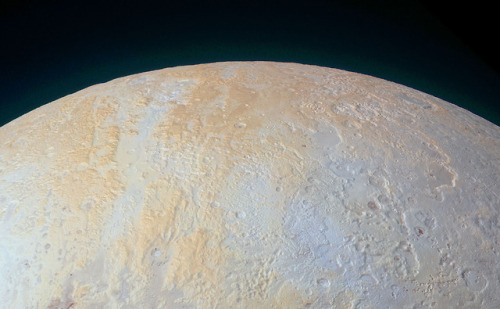
High-resolution images of Pluto taken by NASA’s New Horizons spacecraft.
The plains on Pluto’s surface are composed of more than 98 percent nitrogen ice, with traces of methane and carbon monoxide. Nitrogen and carbon monoxide are most abundant on the anti-Charon face of Pluto (around 180° longitude, where Tombaugh Regio’s western lobe, Sputnik Planitia, is located), whereas methane is most abundant near 300° east. The mountains are made of water ice. Pluto’s surface is quite varied, with large differences in both brightness and color. Pluto is one of the most contrastive bodies in the Solar System, with as much contrast as Saturn’s moon Iapetus. The color varies from charcoal black, to dark orange and white. Pluto’s color is more similar to that of Io with slightly more orange and significantly less red than Mars. Notable geographical features include Tombaugh Regio, or the “Heart” (a large bright area on the side opposite Charon), Cthulhu Macula, or the “Whale” (a large dark area on the trailing hemisphere), and the “Brass Knuckles” (a series of equatorial dark areas on the leading hemisphere). Sputnik Planitia, the western lobe of the “Heart”, is a 1,000 km-wide basin of frozen nitrogen and carbon monoxide ices, divided into polygonal cells, which are interpreted as convection cells that carry floating blocks of water ice crust and sublimation pits towards their margins; there are obvious signs of glacial flows both into and out of the basin. It has no craters that were visible to New Horizons, indicating that its surface is less than 10 million years old.
source | images: NASA/JPL

The Sun photographed in a “specific red color of light emitted by hydrogen gas called Hydrogen-alpha and then color inverted to appear blue.” Courtesy of Alan Friedman (Averted Imagination). (NASA)


HiPOD: Bedrock Exposures in Nirgal Vallis
This observation covers two tributaries and the main channel of Nirgal Vallis. The channel is approximately 610 kilometers long and is named after Nergal, the Babylonian god of war and counterpart to the Roman god of war, Mars. Mars Orbiter Camera image show light-toned bedrock; our high resolution picture can gives us a better view of the channel form and bedrock stratigraphy. (Grayscale cutout is less than 5 km across; enhanced color is less than 1 km.)
ID: ESP_074945_1515 date: 23 July 2022 altitude: 257 km
NASA/JPL-Caltech/UArizona

Andrey Khrzhanovskiy, Butterfy, 1972

HiPOD 18 Jan 2022: Icy Cliffs on Mars
This area, on the western edge of Milankovic Crater on Mars, has a thick deposit of sediment that covers a layer rich in ice. The ice is not obvious unless you look in color.
In the red-green-blue images that are close to what the human eye would see, the ice looks bright white, while the surroundings are a rusty red. The ice stands out even more clearly in the infrared-red-blue images where it has a striking bluish-purple tone while the surroundings have a yellowish-grey color.
The ice-rich material is most visible when the cliff is oriented east-west and is shielded from the sun as it arcs through the sky to the south.
Enhanced color image is less than 1 km across.
ID: ESP_071573_2350 date: 2 November 2021 altitude: 307 km
NASA/JPL/UArizona









“I would like to humanize the space age by giving a perspective from a non-astronaut, because I think the students will look at that and say, ‘This is an ordinary person. This ordinary person is contributing to history.’”
—Christa McAuliffe (September 2, 1948–January 28, 1986)

Blue Glow - 220506


‘jump’
-
 epic-flight reblogged this · 4 years ago
epic-flight reblogged this · 4 years ago -
 ammon-rah liked this · 5 years ago
ammon-rah liked this · 5 years ago -
 dslionface liked this · 8 years ago
dslionface liked this · 8 years ago -
 highlytechnical liked this · 8 years ago
highlytechnical liked this · 8 years ago -
 techno-future-cyber-punk reblogged this · 8 years ago
techno-future-cyber-punk reblogged this · 8 years ago -
 gomosblog reblogged this · 8 years ago
gomosblog reblogged this · 8 years ago -
 hifenoise reblogged this · 8 years ago
hifenoise reblogged this · 8 years ago -
 maxkowski reblogged this · 8 years ago
maxkowski reblogged this · 8 years ago -
 maxkowski liked this · 8 years ago
maxkowski liked this · 8 years ago -
 feardeniesfaith reblogged this · 8 years ago
feardeniesfaith reblogged this · 8 years ago -
 samjohnssonvt liked this · 8 years ago
samjohnssonvt liked this · 8 years ago -
 librationpoint reblogged this · 8 years ago
librationpoint reblogged this · 8 years ago -
 zar-1 liked this · 8 years ago
zar-1 liked this · 8 years ago -
 ascarlettjohanssonsandwich liked this · 8 years ago
ascarlettjohanssonsandwich liked this · 8 years ago -
 consumptionisbeingstandardized liked this · 8 years ago
consumptionisbeingstandardized liked this · 8 years ago -
 obsessive-compulsive-destroyer liked this · 8 years ago
obsessive-compulsive-destroyer liked this · 8 years ago -
 solarpunkivy liked this · 8 years ago
solarpunkivy liked this · 8 years ago -
 kstudio93 liked this · 8 years ago
kstudio93 liked this · 8 years ago -
 jay-jay-gone liked this · 8 years ago
jay-jay-gone liked this · 8 years ago -
 haraldrharfagri liked this · 8 years ago
haraldrharfagri liked this · 8 years ago -
 arhon101 liked this · 8 years ago
arhon101 liked this · 8 years ago -
 teksorbkyva reblogged this · 8 years ago
teksorbkyva reblogged this · 8 years ago -
 thoughtsink reblogged this · 8 years ago
thoughtsink reblogged this · 8 years ago -
 calaculusandme liked this · 8 years ago
calaculusandme liked this · 8 years ago -
 gonnachewrosin liked this · 8 years ago
gonnachewrosin liked this · 8 years ago -
 sleonesia liked this · 8 years ago
sleonesia liked this · 8 years ago -
 nomuken25 reblogged this · 8 years ago
nomuken25 reblogged this · 8 years ago -
 albatross-bumblehand liked this · 8 years ago
albatross-bumblehand liked this · 8 years ago -
 pedjazoo liked this · 8 years ago
pedjazoo liked this · 8 years ago -
 musashidj liked this · 8 years ago
musashidj liked this · 8 years ago -
 procastinationandmasturbtion liked this · 8 years ago
procastinationandmasturbtion liked this · 8 years ago -
 dedtmblr liked this · 8 years ago
dedtmblr liked this · 8 years ago -
 billyclub1969 liked this · 8 years ago
billyclub1969 liked this · 8 years ago -
 theguttgrinder liked this · 8 years ago
theguttgrinder liked this · 8 years ago -
 huldek liked this · 8 years ago
huldek liked this · 8 years ago -
 xxstupidtacoxx reblogged this · 8 years ago
xxstupidtacoxx reblogged this · 8 years ago -
 xxstupidtacoxx liked this · 8 years ago
xxstupidtacoxx liked this · 8 years ago -
 clammyhams liked this · 8 years ago
clammyhams liked this · 8 years ago -
 windowsapologist liked this · 8 years ago
windowsapologist liked this · 8 years ago
